| Film and television watchers of the 21st century have been programmed to expect increasing levels of technological superiority in genre productions, particularly those that involve the fantastic, bizarre, or slightly askew realities associated with science fiction, fantasy, horror, and even modern crime dramas. Over the past century, we viewers have delighted in and applauded special effects advancements such as full-motion mechanical props, claymation, stop motion animation, rotoscoping, and computer-generated imagery. But there still exists a requirement for producing physical change in the human condition, be it minute or extreme, that is created through makeup, or full or partial appliances and bodysuits. |

Rich Knight and R2D2 |
Rich Knight has labored in this field for nearly fourteen years, designing and fabricating a wide variety of special effects for low-budget independent films, big budget Hollywood efforts, and several network television series. His work for the recent direct-to-DVD horror film, William Winckler�s Frankenstein vs the Creature from Blood Cove, included a full-body amphibious creature suit, a Frankenstein monster costume and facial appliance, and makeup and scarring effects for a bride of the monster, a ghost of Victor Frankenstein, and an Ygor-like lab assistant to the requisite mad scientist. Rich�s efforts on this film have been chronicled in an interview that can be found at [www.mjsimpson.co.uk]. But Rich�s career in special effects deserves greater attention since it serves as a template for anyone interested in the people who toil behind the scenes in the film and television industry.
| The Beginning of a Career
Education, of course, does not guarantee employment. Rich�s early years in special effects work were spent honing his craft� mostly for free.
I worked on a lot of student films and volunteer productions when I first began working as a makeup effects artist, most of which were unpaid positions that I took to gain the experience. I also ran a business that sold alien masks, toys, model kits, and novelties, so I have actually been professionally creating monsters, aliens and creatures for nearly 13 years. The name of my company was RK Industries, and our alien baby doll has been featured on the shows Strange Universe, E! News Daily and can also be seen in the X-Files (Episode: �Dreamland II�). After the alien fad wore down I closed RK Industries and have been pursuing effects work for film and television ever since.
My first job as a key makeup artist was for a film called Fear Runs Silent (1999) starring Stacy Keach, Billy Dee Williams and Dan Lauria. I created a yeti type creature, as well as several blood effects and working effects. I also did all of the straight/corrective makeups of the main stars. The film was low budget and released directly to DVD.
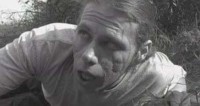
Rich Knight as Salisbury in
Frankenstein vs the Creature from Blood Cove
Before Frankenstein vs the Creature from Blood Cove I worked on many film and television shows some of which include Power Rangers in Space, Power Rangers Lost Galaxy, The Super Adventure Team and X-Files, but of all the jobs I worked before Frankenstein the funnest has to be the �Halloween Horror Nights� at Universal Studios Hollywood. HHN was not a film but an event at Universal Studio�s theme park. I was a regular crew member for the event for three years. The last HHN in Hollywood was in 2000, for whatever reason Universal decided to discontinue the event on the West Coast, which is a shame. I had a lot of fun, made many friends and it was always a fun way to celebrate the holiday.
Recently, I�ve been working for academy award winning makeup artist Matthew Mungle. His shop is known as W.M. Creations. I also run my own shop under the name "Creatures by Knight Studios" (or CBK Studios for short). Due to the nature of this industry I usually find myself only opening up my home based workshop when I am heading up a production. This allows me to keep the overhead to an absolute minimum. When I am not working in my own shop I work for other FX labs or as a freelance makeup effects artist. Some of the shops I have worked for in the past include KNB Effects, Alterian Effects, Michael Burnett Productions, Boneyard FX and W.M. Creations.�
In the course of nearly fourteen years, Rich has expanded his special effects expertise into several areas.
What I love about special effects and makeup is that you are always learning something new. There's really no set way of doing things, and there's always new products and materials that are coming out that help push the limits of live action effects.
I really set no limitations to what I do. Many FX artists will specialize in one area of expertise, but I prefer to take the old school approach. Back in the days when the studios had their own makeup departments an FX artist would have to be able to carry out any and all aspects of the craft. Besides all that, the more you learn and the more you can do the more opportunities will come your way.
I do enjoy designing and creating creatures. I especially like the more advanced stuff like cable controlled puppetry. I have recently started working with translucent skin like silicone and gelatin materials. Over the thirteen-plus years I have worked in this industry I have created many anatomic duplications, dead bodies, body parts, props, makeup appliances, gloves, masks, puppets, full body creature suits, artificial eye balls, teeth, fangs, dentures, bald caps, and more.
| And I really don�t have a preference as to which genre of film I work on. Whether it is sci-fi, horror, fantasy - whatever, what I enjoy is creating a character. It is truly a unique experience to be able to take something that doesn�t exist, design it on paper and bring it life. I really love what I do and I always learn something new and grow as an artist in each new project I work on.
|
It is truly a unique experience to be able to take something that doesn�t exist, design it on paper and bring it life. |
|
Background and Education
I was born in Mountain View California, on the same day that the first man landed on the moon (Neil Armstrong, July, 1969). My parents were working musicians. My father played guitar and sang lead vocals. My mother played keyboards, flute and bass guitar. Together they played in a band called "The Reflections". They even had their own records and nearly landed a record deal with Warner Brother Records back in the early seventies. I was named after their rhythm guitar player and best friend Richard Anderson.
Being raised in a musical family, naturally I picked up guitar and singing as well. I never became quite as good of a guitarist as my father, but I found music a great way to express myself artistically. Both my brother and myself were artists for all of our lives. For as long as I can recall I had the ability to draw. I remember being something like two years old, watching my brother as he drew pictures, to see what he did that made his drawings look cool. I would then apply what I learned to my crayon murals on the walls. My parents weren't so thrilled about the new murals, but they knew that their sons were gifted with artistic abilities far advanced for their age.
My parents moved around a lot when I was younger. I have lived in many different states and cities. I started out in San Jose, CA, then moved to Toledo, Ohio. From there we moved back to San Jose, lived there for about five years and then my father was transferred to New Jersey. And from Jersey I left for school to Hollywood, and later moved back with my parents, this time in Las Vegas. From Vegas I moved to back to California, where I have remained ever since.
I think that I used my art and my music as a means of escape. It was always very difficult making friends, when you knew that soon you'd move and have to make all new friends in a new town. Through my artwork and my music I could literally escape my boring reality into a fantastic world of creative possibilities. I also learned a great appreciation for writing, especially short stories and poetry. My favorite writer to this day is Edgar Allan Poe - an inspiration to me not only in my writing, but artistically as well.
The one thing that really tied the whole family together was movies. Not everyone in the family played music, and those of us that did played different styles of music. I was into Heavy Metal, so was my brother Rob. My father was into Jazz, and he and my mom played top 40 music with their band. So it wasn't exactly like the Partridge Family at our house. So we as a family would often rent a movie and watch as a family. My father was a big sci-fi buff. I remember watching movies like The Day the Earth Stood Still, and Forbidden Planet with the whole family. I grew up watching movies like Frankenstein and The Creature from the Black Lagoon, but I think the most inspirational films for me were the original Planet of the Apes movies and Star Wars. I was also greatly inspired by Tim Burton's Batman.
When I was fourteen I became the second place winner for the "Post Cereal Create a Super Villain Contest". One in one thousand kids win ten speed bicycles for creating a new super villain, and their super villain would appear in a comic book. My winning entry was a villain a created to fight Wonder Woman. I�m not sure what I named the character, I think it was "Destruct-O", or something silly like that. As I recall the character was bald, wore a mask over his eyes, and a fancy red and blue spandex outfit. I really don�t know if they ever used the character in the comic book, but I did get a lot of use out that bicycle.
In 1993 I made the decision. I was torn between music and art. I knew I wanted to go to school, but I wasn't certain of which direction.. So it was between going to GIT (Guitar Institute of Technology) or the Institute of Studio Makeup. Both schools were in LA, so I knew I wanted to be in Hollywood, it was just a matter of deciding what direction to pursue. The decision became easy after I had a falling out with my band. I knew that music was not the direction I wanted to go. I enrolled in the Institute of Studio Makeup in 1993, and have been studying the makeup arts ever since.
|
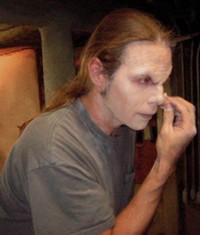
Rich Knight applying his own makeup
Recently my work has been less creature oriented and more based on reality. At W.M. Creations we have been making a lot of dead bodies and body parts for various films and television shows. Sure, making dead bodies isn�t quite as fun as creating a monster, however I believe that it is good to not only focus on making creatures, but rather concentrate on creating believable effects no matter how mundane or fantastic. After all, the best makeup is one that nobody knows is makeup. My real job is creating illusions not just creating critters. When it comes to watching and enjoying movies my favorite is science fiction. I do like horror movies, but I like the classics, I really don�t find today�s horror films to be scary at all, and the creatures are beginning to look pretty generic. I prefer the old Universal films like Karloff�s Frankenstein, when the movie monsters were memorable.
I have been blessed with many great friends over the years that have helped to get me to the level of experience I am at today. In fact I always tell people that if you really want to succeed as an effects artist you must never become too competitive with fellow effects artists. I say this because about 90% of all the work I have received is through my friends in the industry.
Over the years, Rich has come to expect virtually anything and everything in the way of requests from film-makers.
To be honest nothing really shocks me anymore, I have pretty much seen and done it all. I have been called upon to create everything from Frankenstein monsters to three-boobed alien slave girls. One of the more disturbing FX requests asked of me was to create a bleeding effect for an adult erotic horror thriller (which is a fancy way of saying horror porn). They asked me to make a woman bleed from her crotch. Needless to say I passed on the job, and found it a bit tasteless. So after that, I�d have to say that nothing really surprises me anymore these days.
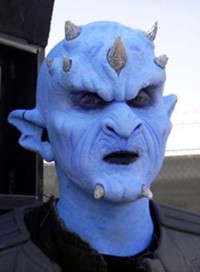
Character creation: Alien Force Alliance
Creating life-casts of actors is a fairly common practice in films, even in these modern times. Genre fans have read many accounts of the trials and tribulations classic horror actors such as Boris Karloff had to endure, but contemporary actors go through as much or more than their counterparts in the Golden Age of genre films.
| This is very true. Foam latex appliances take a long time to apply. A small appliance such as a bullet wound or a cut can take somewhere around 45 minutes to an hour to apply. A multi-piece foam latex appliance can take anywhere from two hours to as much as nine hours. Because of the time it takes to apply these types if makeups it is wise to do as much work in advance as possible. I try to have appliances pre-painted whenever possible so that all that is left to do is glue down, seam and blend the appliance. If the appliances don�t get pre-painted it is likely to take much longer to finish the application. |
A multi-piece foam latex appliance can take anywhere from two hours to as much as nine hours. |
I also try to hire as many assistants as I can to assist in the application. This speeds up the process tremendously, and allows you to focus more time on the makeup itself, not just the seam lines. It can be very frustrating for the makeup artist because we are commonly rushed to the finish line. This is just one of the many reasons that it takes many months, not mere weeks to create something like a full body creature suit. On the major motion pictures and television shows that I�ve worked on in the past I have been fortunate enough to have been given enough time to complete the makeup and make it look good. Most of the low budget indie films have been short on working time, and tend to rush the makeup - again I think it comes down to money.
In the old days it took even longer to apply special makeups. Many of the modern, state of the art materials weren�t around back then. For instance, before alginate was available for lifecasting plaster of paris was used. I can�t imagine how the actors endured that stuff, because it gets really hot when it sets up. I hear that W.C. Fields had such a difficult time with lifecasting that he had the effects artists do the life casting in sections. This actually happened with one of our actors from Beowulf. The actor was claustrophobic, and couldn�t make it through the lifecasting session. After a few attempts the actor refused to do it anymore. So the effects team in London sent us the lifecasts and we were able to piece them together and sculpt in the difference.
On Beowulf, actress Robin Wright-Penn was very concerned about getting clastrophobic. She told us that she was prone to claustrophobia. |
Also on Beowulf, actress Robin Wright-Penn was very concerned about getting clastrophobic. She told us that she was prone to claustrophobia, so I assured her that she was in good hands and told her if she did feel the phobia coming on to try to meditate (as she often practices meditation). I told her that this would not only let us know to work faster, but that it would also soothe her and help maintain calmness. Ironically, the lifecast was going great, and suddenly a family member came into the room where we were making the cast, and she says "Hi Robin, you look like a mummy under that thing, do you feel claustrophobic?� At that point we heard the ohming and knew it was time to get her out. In the end the cast came out perfect, Robin was fine, and even with the slight distraction, our professional crew was able to carry out the lifecasting without a hitch. |
I also had a similar experience with one of the actors from the Frankenstein film that panicked during a lifecast. It�s very common for people to become claustrophobic during a lifecast, and it is nothing to be ashamed of. I try to let the actors know that at any time the material can be torn away. It is a safe procedure when done by trained professionals, but lifecasting is not for everyone. In this case the actor tried to stick it out, but by not letting us know of his discomfort we had to quickly remove the actor as he became fatigued. This ultimately led to us having to do the cast on two separate days.
Lifecasting can be very demanding on the actor, which is why it is a good idea to limit the amount of lifecasting to a minimum. For the Frankenstein film, we did eight lifecasts in one day. We took a half face cast of Lisa Hammer (the monster�s bride) and also her torso; we also lifecasted Corey Marshall�s (the Frankenstein monster) full head, right and left hand, upper and lower teeth as well as half of his full body. This is way more lifecasting than anyone should attempt in one day. At W.M. Creations we usually don�t do more than four lifecasts in one day -- it simply puts too much stress on the actors. Unfortunately some indie film makers won�t allow you the luxury of time, so you can be forced to cram in more lifecasts than should be attempted in a single session. It is wise to avoid this if possible. A good director will be more concerned about the safety and welfare of his cast and crew; a director that is pushy about time, or is just too cheap and isn�t willing to pay for the extra days is just reckless.
I don�t know if things have become better or worse for the modern actor in prosthetic makeup. But what I do know is that we are constantly pushing the envelope of what can be done with makeup and special effects. We are truly at the cutting edge of technology for synthetic silicone skin materials, and the things we can do today are leaps and bounds beyond the old days of Hollywood. . . But the old classic monsters still maintain their timeless quality.
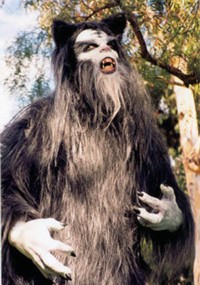
Character creation
While the film business in general, and special effects creation in particular, produce exotic images and moments of wonder that the public watches, reads about, and wishes to be part of, the fact is that the entire process is a grueling, cut-throat business. The process by which film production companies selects special effects creators is not cut and dried.
There�s really no set answer. Production companies base their choices on many different factors. Most of the time it comes down to money. A smart producer is willing to spend extra money and offer additional time if needed in order to make certain that the project runs smoothly - sort of like insurance. Unfortunately most of the independent film makers out there are low ballers looking for the lowest bidder.
| Going to the lowest bidder is probably the dumbest thing one could do. Sure, one doesn�t want to pay too much money for something, but it�s worse to pay too little. If you are to deal with the lowest bidder it would be wise to add something for the risk you run, in which case you would have enough to pay for something better anyway. There isn�t anything in the world that can�t be made a little worse and sold for cheaper. Those who consider price alone are ultimately doing a disservice to themselves. In other words, it is foolish to pinch pennies, especially if the film�s central characters are effects driven. A smart production company will spare no expense to assure the highest quality of special effects for their film. |
Going to the lowest bidder is probably the dumbest thing one could do. |
Most of the work I get is through referrals; however I do sometimes submit a bid for an upcoming film. I might get the job if I bid low, and that is a common mistake made by FX artists. In my experience every time I work for less money than I am worth the project seems to be plagued with problems of a production company unwilling to pay the livable wages needed to maintain a professional crew. Unfortunately money is what drives this industry just like every other industry.
Ultimately what should be the deciding factor in choosing an effects artist is the quality of work, not the cost. If the creature design isn�t good the film won�t make much money, if any. Isn�t it smarter to pay more and get the best quality possible? I think so anyway, however that�s something that comes down to the director and producers, after all they have the final say.
Rich�s participation on the Frankenstein film is an example of the problems associated with lack of an appropriate budget.
Frankenstein was a very low budget film that was shot in a very short amount of time. There was very little money to work with, so I hired an all volunteer crew including myself. Most of the crew members that I hired were beginners, just out of makeup school. The deal was for them to give me three days a week on Frankenstein and I would teach them the advanced techniques of special effects makeup and full body creature suit work. In addition, some of the volunteers were industry professionals, and good friends of mine. In the last two weeks of pre-production I brought these industry friends on board and they were more than happy to help me to meet my deadline. It�s pretty common for FX artists to help out one another, especially when in a crunch as I was. But we all worked without pay because we (the effects crew) shared a love for not only makeup and effects, but also for the classic monsters of yesterday.
I attempted to complete three months worth of work in a month and two weeks. |
This film was especially difficult to work on because the time factor. The director would not allow the effects crew the time that we needed to create all of the makeups and the creature suit... in fact he cut our working time short by two weeks. Despite my warnings that we needed more time to complete the work, the director simply reminded me that I was "contractually obligated" to his production company to complete the work. I attempted to complete three months worth of work in a month and two weeks. I worked seven days a week, usually working late into the evening. |
As we got closer to the start date I was pulling many all nighters to get the work finished in time. In the end we got most of the work done, but we still had no creature suit. The sculpture was completed but there was no one available to mold it - because I was on set, as were any available crew member. I had to drive from my home to the director's home in Woodland Hills, work an entire day on set, then drive home, finish work needed for the next day on set, and then try to squeeze in an hour or two of sleep, then drive back to set the next day. This caused makeup to be consistently behind schedule throughout the shooting.
I also warned him of the poor weather predicted by the Farmer's Almanac. One of the scariest days on set for me was when we shot out on Gaviotta Beach, while it was raining. I remember watching the tide come in closer and closer - no one knowing the exact times of the tide. At one point I had to pack up my set kit and carry it up the hill to my car for fear that the tide would eventually trap me on the beach. This was very unsettling.
It was also especially frustrating for myself and my crew because there was no production staff - no one, it was all just the director and his wife running the production company. So if you had any scheduling conflicts, budget constraints or any issue pertaining to your department's needs you had to take it directly to the director. On top of all that, there were no call sheets, locations, maps, nothing! The production was very unprofessional, even the student films I had worked on in the past gave call sheets!
The director also tried to add as much more to the special effects as he could get away with. He wanted me to sculpt larger breasts for Lisa Hammer as the Bride of the monster. When we took Lisa's lifecast she was sitting on a gravity chair. This gravity chair was specially designed to allow the person seated in it to flatten out their spine... it is used as therapy for people with bad backs. I used it because it perfectly positioned our model for lifecasting her chest area. Because of the design of this chair gravity pulled Lisa's breasts flat, allowing for a nice surface on the lifecast where the autopsy incision can be sculpted in.
After the director saw Lisa's flattened down lifecast he insisted that I sculpt breasts to make Lisa appear larger. I tried to explain to him that gravity had caused the breasts to flatten and when she stands up her breasts will appear normal again. We argued over this much to my frustration, which also bothered the female members of my crew immensely as the director used terms such as "too androgynous" or "boyish". Lisa Hammer is my friend, and she is a very talented actress and beautiful woman, so it was a very difficult position he put me in when he suggested that either I sculpt larger breasts or he may have to re-cast the role. I finally explained it would add additional work for me that I neither had time nor money to do.
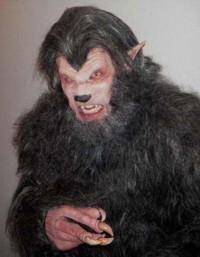
Character creation: Classic werewolf
But are major pictures always more satisfying because there is more budget leeway to work with?
Yes and no - On the one hand it is very satisfying that there is a significant budget to work with on major productions. On all of the projects I have worked on at W.M. Creations we have had access to all the materials needed to complete any given effect asked of us. Some of the materials we commonly use are tin and platinum based silicones, urethanes, foam latex, slip latex, gelatin, acrylic polymers and monomer, alginate, plaster, rigid and flexible urethane and fiberglass. Although the material budget is significantly higher on major motion pictures the time factor still remains, and many times we are given last minute jobs with crazy deadlines.
I think that the major difference between the bigger budget films verses low budget independent films is that there is usually more organization. The key word here is "usually". Most major motion pictures have full production staffs which allow you to plan your working schedule accordingly. It is common to receive a call sheet with all the information needed, including call times, day player info, location info and directions, sunrise and sunset times, the time that tide comes in (if working on a beach location), etc. This sort of information is what makes things run smoothly, and the major studios know this.
Many indie film makers fly by the seat of their pants |
The upside to a major motion picture is that they can allow enough time and money for last minute changes whereas an indie film maker is limited to what they can afford, which can lead to serious issues during filming. For instance bad weather could literally close down your production, costing hundreds if not thousands of dollars. A smart production staff looks far ahead into the future, checking things like a Farmer�s Almanac, to make certain the weather won�t hinder the shooting schedule. Many indie film makers fly by the seat of their pants believing that it�s a waste of time to worry about those sorts of issues, then they scratch their heads in disbelief when a sudden hail storm brings shooting to a screeching halt. |
This is why it is a bad idea for indie film makers to attempt to make effects driven movies without having a proper budget. They simply can�t afford to make a good film with the proper care and respect the genre deserves. There are of course a few indie films that have come along that have challenged this notion, but what you will likely find about those few films is that they were planned out and budgeted properly. It is possible to make a good indie film, but you have to be able to pay your crew a livable wage, and have every day realistically planned out, with enough of a budget to carry off the production. I have yet to work on an indie film that didn�t suffer from budget and scheduling problems.�
Let�s talk about some of the major films you�ve worked on lately.
�At W.M. Creations I have had the privilege to work on some very high profile films. One of those films that I am really looking forward to is Robert Zemeckis� upcoming feature Beowulf, an animated feature starring Ray Winstone, John Malcovich, Anthony Hopkins, Crispin Glover, Robin Wright-Penn and Angelina Jolie. The digital FX team used the most state of the art technology to bring this classic tale to life. At W.M. Creations we lifecasted the entire cast including all of the background and stunt performers. We then created silicone molds of the actor�s entire head which were then used to create motion capture helmets. We also made vacuform face masks which allowed the set makeup artists to mark precisely where the motion capture sensors would go on a daily basis.
This is the same technology that was used to bring the Gollum creature to life in the Lord of the Rings trilogy. I truly believe that this film will make motion picture history and I am really proud to be a part of it. The other exciting aspect of this film is how the makeup effects department was able to work hand in hand with the CG effects people. So many people seem to be concerned that CG is taking work from makeup effects artists, and that makeup effects will eventually become obsolete. Well this is a perfect example of how makeup effects artists can not only continue to work in the film industry but also thrive. There is still a need for sculptors, mold makers and life casters even in CG animation, so there�s still work available. Although I am not a huge fan of CG, I respect it for what it is and accept its place in the industry.
�We had a crew of five working exclusively on Beowulf. The motion capture supervisor was Kris Kobzina. Ryan McDowell and Eddie Vargas supervised other aspects of the project. Other crew members were Neal Kennemore (also a crew member of Frankenstein vs the Creature from Blood Cove), Matt Jorgensen, Carlton Coleman and myself. I assisted on lifecasting some of the cast; however my main job was to create silicone case molds of actors. I believe that in the end we lifecasted and made molds of somewhere around 50 actors. From what I have seen of the designs it looks like this film is going to be very, very cool! I don�t want to give away too much, but the finished animated film will look something like an oil painting come to life. The film is set for a 2007 release.�
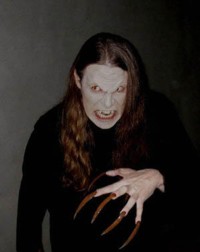
Character creation: Knight as the vampire in Night Walker
Rich also worked on the upcoming X-Men 3.
�W.M. Creations was hired to create some of the mutants for the upcoming super hero movie X-Men 3. We made various sewer dwelling mutants, and also created the baby angel wings for one of the main characters. I worked mainly in the molding department on X3, and was bouncing back and forth between Beowulf and The Omen 666, so unfortunately I didn�t get the opportunity to do much more than make molds of the various mutants. I did do some design work, however only one of my ideas was used. What I can say about this production is that there will be more mutant characters and makeup designs in this film than in any of the previous X-films.�
What about The Omen 666?
For The Omen 666, a remake of the 1976 classic starring Gregory Peck and Lee Remick, I made a much larger contribution. I helped to create a burned body, a demon character and a working effect of a decapitated head. The most interesting effect was the decapitated head. We made a lifecast of the actor, and then created a silicone duplicate of the actor�s head. From there we created a fiberglass body which would support the head and allow for the decapitation effect to work. I don�t want to bore your readers with all the details on constructing the effect, but I will say it took a bit of tweaking but we finally got that effect to work great. I just recently saw the photos from the set in Prague, Czech Republic and everything looks really fantastic. I absolutely loved the original Omen so I don�t know if this remake will do the classic justice or not, but from what I have seen thus far it looks like it will be a quality film nonetheless. One of the more interesting things about working on The Omen 666, that actually became something of an ongoing gag around the shop, was the string of minor injuries which occurred to the people that worked on the film. I cut my hand on a plastic bucket of all things; I still have a scar from it. Other crew members suffered similar minor cuts and scrapes, and it became a funny coincidence that the omen curse had seemingly manifested itself in our shop in the form of minor injuries.� [Note: The Omen 666, starring Live Schreiber, Julia Stiles, Mia Farrow, and David Thewlis, is scheduled for a 2006 release.]
Rich also worked on a war film entitled Seraphim Falls.
�For Seraphim Falls I created a neck appliance for an actor that gets stabbed in the neck. I also made lifecasts of actors, created molds and helped to create working effects. In order to keep working as an effects artist you have to able to do more than just monsters. Most of the work that is available is for wounds and injuries, dead bodies or working/bleeding effects. I do prefer making monsters or aliens, of course they are more fun because they are more fantastic, but it is also very rewarding to create something that is realistic. It�s actually a lot easier to make a monster than it is to sculpt a likeness of a person. A monster leaves you room for creative interpretation whereas duplicating real life takes extreme detail. The work can be tedious, but the end result can be amazing.�
Rich then talked about some of his recent television work.
| I was brought on to CSI for it�s sixth season. I�ve created all sorts of dead bodies and body parts for CSI since I was brought on board. I was on set for the Thanksgiving episode in which we made a man�s stomach explode from overeating. In the autopsy scene it is actually me breathing air into the lungs. CSI is a fun show to work on, and I must admit that I have become a big fan of the show. Because CSI is ongoing, I am often called upon to create effects for the show. |
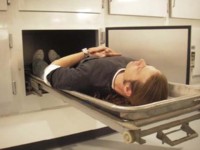
Rich Knight playing dead
|
Most recently I have been working on NCIS, a similar show about crime scene investigators. I have to say that is very rewarding to be able to work on such hit shows as CSI and NCIS, both of which remain in the top ten in TV ratings. All the acronyms can get confusing sometimes, as I have often caught myself referring to either one of the shows as NSI or NCS or something of that sort. All that aside, they are great shows to work on and I look forward to a continued working relationship with those shows.
How often are special effects people called upon to act in films?
Actually, it happens more often than you might think. Rick Baker has played a few roles in character makeup and creature suits. He was in the King Kong suit in the �76 remake. He also had a cameo part as an ape in Tim Burton�s remake of Planet of the Apes. FX artist Greg Nicotero of KNB Effects had parts in Land of the Dead, From Dusk Till Dawn, and House on Haunted Hill. It�s not uncommon to be asked by a director to act in their film, especially in independent pictures (I, for example, played the part of Salisbury, the scarred lab assistant in the Frankenstein film). Sometimes there is a need for background actors, and sometimes simply out of convenience. For example, as an FX artist you may already have appliances, fangs or special FX contact lenses that can be used to create the monster for their film. Rather than having to hire an FX artist to create the effects from scratch, the artist is hired to play the creature. It saves time and money, and it sweetens the deal in some cases for the effects artist. I know that I enjoy acting and doing the effects work. It sort of feels like stepping into the shoes of such FX artist-actors as Lon Chaney, Sr., and Tom Savini.
In the film I play a TV vampire from an old B&W movie. |
Shortly after filming completed on Frankenstein vs the Creature from Blood Cove, I was cast to play the part of a vampire in director Matt Galvin�s film Night Walker. In the film I play a TV vampire from an old B&W movie. The premise of the film is that a child suspects his new neighbor to be a vampire. I created my own vampire makeup, fangs and claws. I had my friend John Hart (also a crew member from Frankenstein) run the foam latex for me. |
Shortly after filming completed on Frankenstein vs the Creature from Blood Cove, I was cast to play the part of a vampire in director Matt Galvin�s film Night Walker. In the film I play a TV vampire from an old B&W movie. The premise of the film is that a child suspects his new neighbor to be a vampire. I created my own vampire makeup, fangs and claws. I had my friend John Hart (also a crew member from Frankenstein) run the foam latex for me.
Soon after filming completed on Night Walker I was cast in director Matt Theisen�s horror satire Killer Sound. I play the part of a keyboard player that is kicked out of his band, and suspected of killing his bandmates after the break up. Killer Sound was a really fun project to work on. I also did the FX as well as act in the film. I brought my good friend Neil Kennemore and Felvi Hernando (from FVTCFBC) to assist on the FX work as well. Neil is a great sculptor and comes from a family with a long history in the FX industry; he sculpted a head of one of the actress� that gets cut off and then cooked in a microwave. I just found out that we have Dr. Fink, the keyboard player from Prince and Revolutions, doing the big keyboard solo that is a principle part of the story. I am really excited about this film, it�s going to be very funny and thrilling. We plan to take Killer Sound to film festivals and horror conventions in the near future. I truly think that this film will get much attention as it is a very clever and witty film, very much like This is Spinal Tap meets The Twilight Zone.
In addition to all this activity, Rich is also trying his hand at independent production.
| I am self producing a puppet show called The Ruff and Skitch Show. Because I am self producing this show, it is a slow process, but it has become a project that I am quite fond of. There�s over forty different puppet characters in the Ruff and Skitch universe. The puppets will be animatronic, and will feature moving and blinking eyes as well as articulated mouths. I am also designing makeups and body suits for some of the characters, so the entire show will be a combination of puppets and live actors.
The great thing about Ruff and Skitch is that the stories are based on real life experiences. The stories revolve around a dog and cat that are homeless and each episode is a different story of how they make the best of their situation. Each episode does something very unique for this day and age of story telling. . . the stories have a moral lesson. |
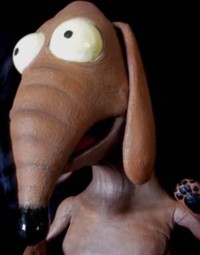
Ruff
|
I have always enjoyed stories that both entertained and taught something, and I think that a lot of writers today have forgotten about having the story actually make a point. It seems that most the movies and TV shows are all sensationalized, and really only contain action, explosions, nudity and fluff... but there�s no substance. Well the charm with Ruff and Skitch is that there is substance. The stories are very funny and are not just for kids. Like the old Looney Tunes cartoons, I have written each script with multiple levels of humor, jokes that both kids and adults will find funny. Most of all Ruff and Skitch is a show that the whole family can enjoy, and did I mention it�s funny?�
Although the question has become trite in terms of standard interviews, Rich was nevertheless asked to provide some advice to anyone interested in becoming a special effects artist.
The first thing you need to do if you want to work as an effects artist is to learn the craft. To become a good special effects makeup artist it takes years of practice and dedication. It�s not an easy craft and it takes a lot of practice to get good at it. You should try to learn as much as you can about the craft. Study about other FX artists from the past, learn about new products and materials, and study new techniques. It is also very important to get to know as many effects artists as you can. Other artists are your best means of getting work, so get out there and network. And most importantly DO NOT COMPETE with other artists. Sure, a friendly and good spirited competition is fine, but you shouldn�t think of another FX artist as the enemy competing for a gig. The truth is that most of the live FX work that is available today requires a team of artists. Naturally when the work is available you want to hire your friends as part of the crew, so the more FX artists you have as friends the more likely the chance that you will receive a referral from a friend.
| There certainly are plenty of perils and pitfalls out there to avoid. The biggest of which is the old "deferred pay" scam. This is where a production company promises to pay you after the movie has made money. I have yet to hear of anyone that has ever been paid by deferment. From what I understand the scam works because a legitimate looking contract is used, but it is filled with legal loop holes that allow the production company to get out of having to pay. The common scam is for them to sell the film to a relative at a loss, thus ridding themselves of any legal obligations to pay, the movie can then be sold back to the original production company (at this point usually with a new name) and then sold commercially. |
There certainly are plenty of perils and pitfalls out there to avoid. The biggest of which is the old "deferred pay" scam. |
There certainly are plenty of perils and pitfalls out there to avoid. The biggest of which is the old "deferred pay" scam. This is where a production company promises to pay you after the movie has made money. I have yet to hear of anyone that has ever been paid by deferment. From what I understand the scam works because a legitimate looking contract is used, but it is filled with legal loop holes that allow the production company to get out of having to pay. The common scam is for them to sell the film to a relative at a loss, thus ridding themselves of any legal obligations to pay, the movie can then be sold back to the original production company (at this point usually with a new name) and then sold commercially.
When you are beginning in this industry you really need to get experience by volunteering your time, but you must choose carefully how you will donate that time. I suggest working on student films, or for a local theater. Be careful of taking on a no pay gig -- in most cases you will be treated poorly and disrespected because you are working for free. A volunteer gig should be of low impact to your schedule so that you can still maintain some sort of employment, preferably on weekends. I also recommend that you be very clear with the production company as to why you decided to donate your time to their project. Let them know that you don�t usually work for free and this is the exception. By doing this you will receive more respect by the production company and the crew. Suddenly you�re not just someone that is eager to work in the film industry but instead you are someone with talent that is willing to donate it to the production. As strange as it sounds it truly makes a difference in the way you are treated.
Finally, have respect for yourself and the people you work with. As a professional makeup artist you will definitely be working up close and personal with actors and celebrities. It�s not uncommon for actors to run their lines while you are applying the makeup. Many times actors will confide in you things that they wouldn�t normally tell any of the other crew members. If you think about it, as a makeup artist you have to violate the actor�s personal space, and basically make close contact with their face (or other body parts) and paint. As well, the makeup artist is the one that hides the actors flaws.. which means we know all of them quite intimately. The relationship between a makeup artist and actor is usually pretty close. I think that this is what led me to cross over into the acting field as well.
Does acting require the addition of a SAG card and associated union dues in addition to any other industry union?
At this time I am not a union makeup artist. I�m not in SAG either. For now I continue to work as an independent. It is, however, inevitable that I will eventually join one or more unions. But for now I�m just staying busy. Fortunately because I work for W.M. Creations, it allows me the opportunity to work on union productions without having to be a union member.
Return to:
 |
Click on the icons for new features in The Thunder Child.
Radiation Theater: 1950s Sci Fi Movies Discussion Boards
The Sand Rock Sentinel: Ripped From the Headlines of 1950s Sci Fi Films
|
 |
|
















